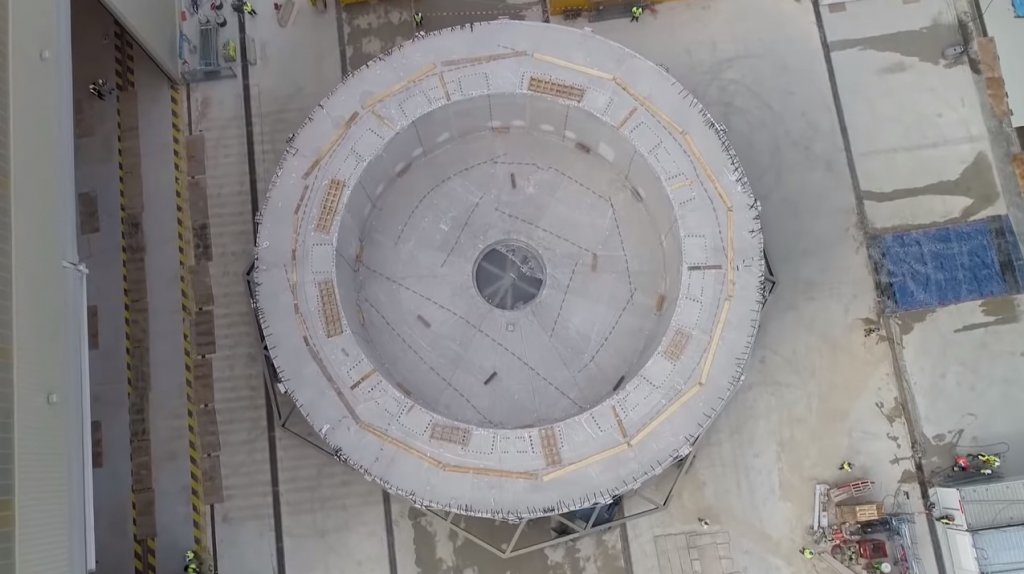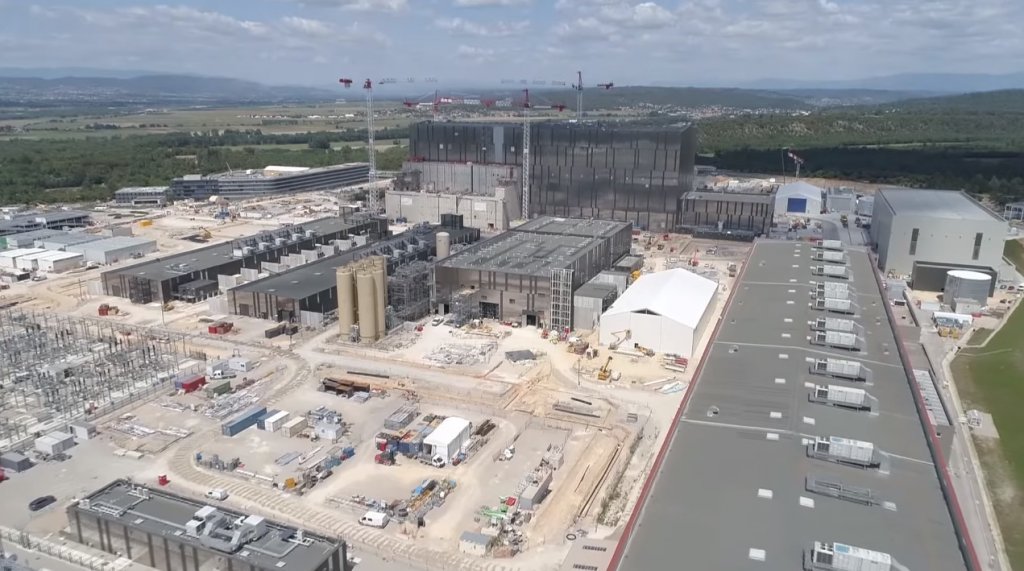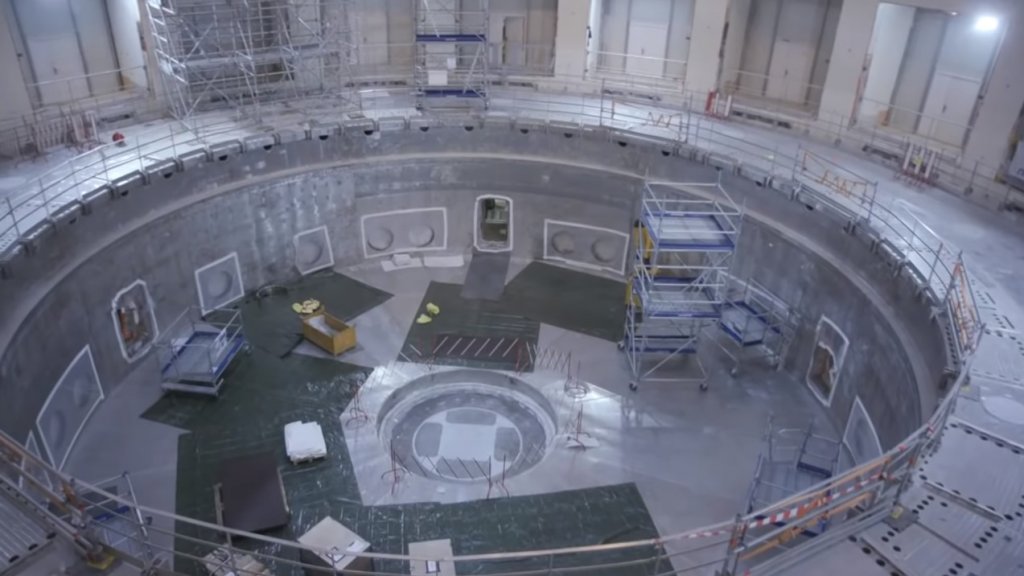Artificial sun: the United States and Russia are building a unique thermonuclear reactor
Construction of the world's first experimental thermonuclear reactor, ITER, has begun at the Cadarache research center in the south of France, 65 km from Marseille. The opening ceremony was started by President Emmanuel Macron to music from the Star Wars movie saga, writes Air force.

Photo: video frame YouTube / iterorganization
As noted by Wikipedia, the name ITER (ITER) was originally an abbreviation for the English International Thermonuclear Experimental Reactor (International Thermonuclear Experimental Reactor); now the name is associated with the Latin word iter - path.
Scientists seriously call ITER an artificial sun. In a vacuum chamber the size of a 10-story building - 30 meters in height and the same in diameter - it is planned to reproduce on an industrial scale the thermonuclear fusion process that powers our star.
Russia is not only one of the main partners of this ambitious scientific project, but also its oldest participant. The very idea of a thermonuclear reactor, which the whole world is now trying to implement without exaggeration, belongs to Soviet scientists from the Institute of Atomic Energy. Kurchatov.
In theory, thermonuclear fusion is an inexhaustible source of energy. Just a few grams of hydrogen fuel is enough to provide heat and electricity to thousands of homes, and a “briquette” the size of a pineapple can replace 10 thousand tons of coal.
Only unlike traditional thermal or nuclear power plants, a thermonuclear reactor does not pollute the atmosphere with greenhouse gas emissions and does not leave toxic radioactive waste.
“We were inspired by the Universe and the stars, where nuclear fusion creates energy for billions of years to come,” said ITER Director General Bernard Bigot.
Project participants emphasize: ITER is an experimental reactor. This is not a thermonuclear power plant, but a site for an unprecedented physical experiment.
However, if everything goes according to the plan, this experiment will determine the future of all energy on the planet.
“ITER is an absolutely amazing scientific project. “He united the whole world to create a clean and renewable source of energy - the energy of the future,” Ian Chapman, head of the British Atomic Energy Agency, told the BBC. “This is an opportunity to demonstrate to the whole world that thermonuclear fusion is possible on Earth.”
On the subject: 35 countries are building the world's largest fusion reactor: why is this needed. PHOTO
Sputnik, caviar, vodka, tokamak
ITER is the largest scientific construction project in human history. 35 countries are taking part in the experiment, including India, China, Russia, the USA, South Korea, Japan and EU countries (plus Great Britain and Switzerland) - this is 80% of the entire world economy and more than half of the planet's population.
At the same time, all participating countries recognize that the author of the idea of a thermonuclear reactor belongs to Russia. The very word “tokamak” (this is the name of the type of reactor installation) is a Russian abbreviation: a toroidal chamber with magnetic coils.
“A tokamak is a doughnut made of plasma through which current flows,” Anatoly Krasilnikov, head of the Russian ITER agency, explains to the BBC. - This is one of those words that the whole world learned thanks to Soviet and Russian scientists. “Sputnik”, “caviar”, “vodka”, “tokamak” - any foreigner will understand these words without translation.”

Photo: video frame YouTube / iterorganization
Krasilnikov has been engaged in thermonuclear fusion (or, as experts call him, thermonuclear fusion) for over 40 years. In 1981 he graduated from Moscow Institute of Physics and Technology and went to work at the Kurchatov Institute. And in 1985, a historic agreement was signed between the United States and the USSR on the joint construction of a tokamak.
“Gorbachev and Reagan agreed to build a reactor together as an example of the fact that two great powers can not only fight against each other in the Cold War, but also do something together, implement some kind of joint scientific projects,” Krasilnikov recalls. “And soon Japan and the European Union joined us.”
After the end of the Cold War, the United States unilaterally withdrew from the agreement, in the expectation that without American funding the project would have to be curtailed. However, the remaining partners continued their work - moreover, India, China and South Korea joined the development of the tokamak. In Washington, it seems, they realized that they had miscalculated.
“Then the States asked to come back, and, it seems, they were accepted back in 2004,” said the head of the Russian ITER agency. - So, if they come out now, it’s okay. The project is not determined by them, and they are not the key contributors.”
After the French Cadarache was approved as the site for the construction of the reactor, the EU took over the bulk of funding (45%). The rest of the expenses of the participating countries, including Russia and the United States, are divided equally.
On the subject: USSR space satellites launched with a nuclear reactor on board: one of them fell in Canada
"This is the Sun on Earth"
The fuel in a tokamak is two types of hydrogen (they are called isotopes) - deuterium and tritium. Unlike oil, gas and uranium ore, the reserves of both are practically unlimited: one is extracted on an industrial scale from the waters of the World Ocean, the other from lithium, as a result of a rather simple reaction.
Hundreds of tokamaks have been created in the world, but ITER is the first reactor where thermonuclear fusion is planned to be supported by a chain reaction of combustion of the plasma itself. To do this, you “just” need to heat the hydrogen to several million degrees and somehow hold it in place, preventing the hot plasma from scattering.
“This is the Sun on Earth, only with a temperature 10 times higher,” explains Krasilnikov. - But the Sun is a huge ball, it holds itself up due to gravity, and we use a magnetic field for this. It’s impossible to melt it - it’s like a magnetic wall, and this is the uniqueness of the Soviet invention.”
How it works:
- several grams of deuterium and tritium, hydrogen isotopes, are injected into the hollow ring of the tokamak;
- hydrogen is heated to temperatures of several million degrees, turning into plasma - an ionized gas in which electrons are torn from the nuclei of atoms;
- the magnetic field, provided by superconducting magnets with a total weight of 10 thousand tons, holds the plasma and gives it its shape;
- when the temperature reaches about 150 million degrees (this is 10 times hotter than the sun), a thermonuclear reaction begins;
- deuterium and tritium atoms merge, forming one helium-4 atom and one neutron, which has a huge energy (about 3,5 MeV);
- neutrons leave the magnetic trap and, due to their kinetic energy, heat the water in the walls of the tokamak;
- the water turns into steam, which turns the turbines.
But the main difference, according to scientists, is the absolute safety of a thermonuclear reactor, since there is simply nothing to explode there.
“In the event of an accident, our donut will simply go out and will have to be re-lit,” Krasilnikov assures. — The plasma temperature in ITER is about 200-300 million degrees. Even if it happens that the magnetic field fails and the plasma splashes onto the wall of the reactor, the temperature will immediately drop by an order of magnitude - and the reaction will simply stop.”

Photo: video frame YouTube / iterorganization
“Everything that humanity has ever created”
All experts agree that no country in the world would have been able to carry out a grandiose project alone. And it's not even about money, but about the unique know-how developed by scientists in the framework of international cooperation.
“Essentially, this is a club of technologically advanced countries, each of which brought its own technology to the project,” Krasilnikov assures. “We came up with a tokamak, someone came up with the first wall, someone came up with a method of additional heating, someone came up with the best injectors, and someone came up with superconductors... ITER united on its site everything that humanity has ever created.”
For example, the magnetic coils of a reactor. Each of them is the size of a four-story house and weighs 360 tons. To create superconductivity, the magnets are cooled with liquid helium to -269 degrees Celsius.
The 13-meter center solenoid weighs 1000 tons and creates a magnetic field strong enough to lift an aircraft carrier into the air.
Most systems are created in collaboration with several partners. For example, one of the parts collected on Tuesday was created under Russian responsibility - that is, developed by Russian scientists in St. Petersburg (Efremov Research Institute of Electrophysical Equipment) - but was assembled by contract workers in Germany.
Under the partnership agreement, all ITER member states have equal rights to use the tokamak and all technologies used in its construction. Leaving the project, any participating country runs the risk of being in scientific isolation.
However, no one is going to go out. According to the project participants, ITER is also a unique social experiment: when people from different cultures, with different mentalities work together, they learn from each other and understand how to communicate with each other - and this is no less important than everything else.
“In a political sense, our countries will certainly experience both warming and cooling of relations,” Krasilnikov suggests. “But ITER will move forward like an icebreaker.”
Read also on ForumDaily:
More terrible than coronavirus: starvation threatens millions of people in the poorest countries
Helps master the Moon and Mars: mold from Chernobyl can protect astronauts from radiation
The Pentagon accused Russia of testing weapons in space
Subscribe to ForumDaily on Google NewsDo you want more important and interesting news about life in the USA and immigration to America? — support us donate! Also subscribe to our page Facebook. Select the “Priority in display” option and read us first. Also, don't forget to subscribe to our РєР ° РЅР ° Р »РІ Telegram and Instagram- there is a lot of interesting things there. And join thousands of readers ForumDaily New York — there you will find a lot of interesting and positive information about life in the metropolis.











